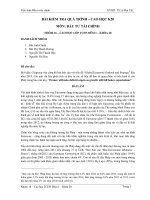Tiểu luận Đầu tư tài chính A CAPITAL ASSET PRICING MODEL WITH TIMEVARYING COVARIANCES
Bạn đang xem bản rút gọn của tài liệu. Xem và tải ngay bản đầy đủ của tài liệu tại đây (1.11 MB, 22 trang )
A CAPITAL ASSET PRICING MODEL WITH TIME-
VARYING COVARIANCES
GVHD: TS. Trần Thị Hải lý
Nhóm thuyết trình:
1.Trịnh Quang Công
2.Bùi Thị Thùy Dương
3.Mai Thị Huỳnh Mai
4.Chung Ngọc Nghi
5.Nguyễn Thị Ánh Ngọc
Contents
I. Introduction
II. Econometric Methods
III. Data Description
IV. Model Estimates
V. Diagnostic Tests
VI. Conclusions
I. Introduction
The assumptions:
1.
All investors choose mean-variance efficient portfolios with a one period horizon,
although the need not have identical utility functions
2.
All investors have the same subjective expectations on the means, variances, and
covariances of returns
3.
The market is fully efficient in that there are no transaction costs, indivisibilities, taxes,
or constraints on borrowing or lending at a risk-free rate.
In this paper we focus attention on the possibility that agents may have common expectations on the
moments of future returns but what these are conditional expectations and therefore random variables
rather than constants.
y
t
: the vector of excess returns of all assets in the market measured as the nominal return during
period t
µ
t
and H
t
: vector and conditional covariance matrix of these returns give information available
at the time t-1
ω
t-1
: vector of value weights at the end of the previous period
The excess return on the market: y
Mt
= y’
t
ω
t-1
.
The CAPM requires:
µ
t
= δ H
t
ω
t-1
(1)
With:
δ = constant
σ
2
Mt
= ω’
t-1
H
t
ω
t-1
µ
Mt
= ω’
t-1
µ
t
,
(1) => µ
Mt
= δ σ
2
Mt
(2)
β
t
= H
t
ω
t-1
/σ
2
Mt
substituting in (1), (2) =>
µ
t
= β
t
µ
Mt
(3)
In the special case:
E (y
t
) = δ V (y
t
)ω – δ
3
V(H
t
ω) ω
II. Econometric Methods
Model: The multivariate GARCH (GARCH-M)
For y
t
N x 1, GARCH
(p-q)
– M:
(4)
(5)
(6)
The GARCH (1,1) model becomes:
III. Data Description
Bills (6-month Treasury bills), bonds (20-year Treasury bonds), stocks
Quarterly percentage returns from the first quarter of 1959 through the second quarter of 1984
(102 observations)
The Standard and Poor’s 500 equity series was used with Citibase interest rates.
New York Stock Exchange value-weighted equity returns are used with Salomon Brothers bill and
bond yields
Mean of Excess holding yield Excess return
Return Standard deviation
Max Min
Time Rate Time Rate
Bill (6 month) 0.142% 0.356 Q2/1980 2.046%
Q1/1980
Q3/1980
Q4/1980
-0.462%
-0.777%
-0.515%
Bond 0.761% 6.255 Q2/1980 22.274%
Q2/1980
Q3/1980
-18.461%
-14.422%
Stock 0.995 % 2.225 Q1/1975 3.746% Q3/1974 -8.642%
IV. Model Estimates
The negative premia observed for bonds and equities in some periods could be due to the
preferential tax treatment as previously mentioned.
Figures 4-6 are the estimated betas.
The beta for stocks is close to one, that for bonds is slightly above one and that for bills is
close to zero
Substantial movement over the sample period
V. Diagnostic Tests
LM test involves the inclusion of the own conditional variances in each of the three equations for
the conditional expectation of the excess holding yields
A better measure might be the nondiversifiable risk as given by the conditional covariance with the
market
The next test considers the lagged excess holding yields as explanatory variables for each of three
risk premia => rejects the formulation of the CAPM given in (8)
Use information in addition to past innovations in forming their expectations
This ability of the lagged dependent variable to help forecast return
VI. Conclusions
The conditional covariance matrix of the asset returns is strongly autoregressive.
The expected return or risk premia for the assets are significantly influenced by the conditional
second moments of returns.
Information in addition to past innovations in asset returns is important in explaining premia and
heteroscedasticity.
Lagged excess holding yields and innovations in consumption appear to have some explanatory
power for asset returns.









